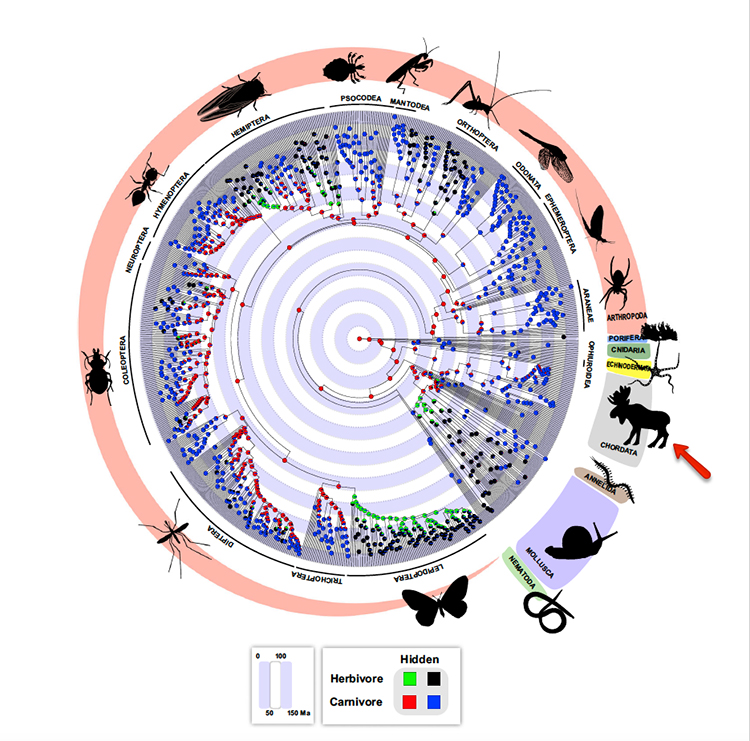Consider the phrase, “you are what you eat.” While most frequently, it is applied to our diet’s effect on our health or our microbiome, can diet play a more significant role in evolution’s play? A paper from Evolution Letters asks some questions about the interaction of diet and evolution.
The approach was straightforward; the researchers identified the roughly 35 phyla of biology’s animal kingdom and representative classes within those phyla trying to identify and balance the dominant species to create a proportional sample – better to avoid over or underestimation of their outcomes, whether they were carnivores, herbivores, or omnivores. This hierarchy or phylogeny was based upon DNA sequencing. Not to worry, here is the graphic. [1] Our phyla, Chordata, is depicted by the moose.

Prepare to be humbled. Overall, the roughly 1100 creatures included 85% arthropods, 6% mollusks, and 5% chordates; and when all was said and done given the nearly 21 million animal species, 85% were carnivores, 14% herbivores, and 1% were switch-hitting omnivores. To be clear, carnivores feed on “other animals, fungi or protists;” herbivorous eat “land plants, algae or cyanobacteria for food,” and omnivorous eat from the entire buffet.
In analyzing diet by biologic taxa they found
- Diets were evolutionarily “conserved” they did not “vary randomly across species.”
- Dietary types did not alter the rates of diversification within species
- Overall, carnivorous species appeared first passing on that trait to the current survivors. Herbivores evolved independently and later. For most animals, carnivores were our ancestors.
In considering their results, the researchers provide some intriguing considerations. One factor that may drive the conservation of diet is the inability of animals to extract nutrients from plants requiring “specialized gut endosymbionts” – our gut microbiome. Vertebrates that are herbivores have higher body temperature, perhaps to keep those little gut critters comfortable. Another driver may be that specialization, in this instance of diet, has some advantage over the generalists, the omnivores.
While certain herbivore lineages, including our own, the mammals, diversified faster, there was no evidence of diet promoting or retarding diversity. Instead, the researchers pointed to an alternative belief that diversification rates increased in the presence of a skeleton, living upon the land, and parasitism – one organism living in or on another
Finally, their findings seem to run counter to the similar studies of diet based upon fossil records that infer that our ancestors were herbivores. They ascribe the contrary conclusions to a varying definition of carnivores based on how rather than what they ate.
The Role of Niches
There is a broader implication in their work having to do with the niche, the neighborhood, of animals. As you would expect, the definition of neighborhood varies. A Grinellian niche is based upon habitat, the particular mix of landscape and other creatures to which we behaviorally adapt. An Eltonian niche is defined by relationships, specifically within the food chain, who we eat and who eats us. Climate change most obviously impacts Grinellian niches, for example, the concern over habitat loss for polar bears. But it can impact Eltonian niches as well, for example, that rising atmospheric carbon dioxide will result in more, but perhaps less nutritious plants. The current study supports an Eltonian view that our position in the food chain is conserved over long periods of evolutionary time. I suspect that both definitions are pertinent; habitat and our position on the food chain, our food network, are more interactive than the definitions suggest. The study also points to one of our exceptional qualities; we are among the rare ones, the omnivores. One has to wonder and hope whether that will continue to serve our species well.
[1] For those, like me, that need to brush up on the taxonomic order it is Kingdom, phylum, class, order, family, genus, species.
Source: Evolution of diet across the animal tree of life Evolutionary Letters DOI: 10.1002/evl3.127




